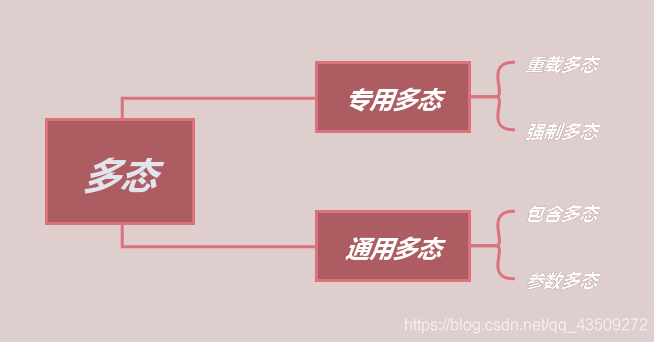多态
多态性总结
多态性概述
多态是指同样的消息被不同类型的对象接收时导致不同的行为。
多态类型

类型举例
1.重载多态
运算符重载:是对已有的运算符赋予多重含义,使同一个运算符作用于不同类型的数据时导致不同的行为
运算符重载为类的成员函数:
返回类型 operator 运算符(形参表)
{
函数体
}
运算符重载为非成员函数:
返回类型 operator 运算符(形参表)
{
函数体
}
operator是定义运算符重载函数的关键字。
将单目运算符“++”重载为成员函数:
#include<iostream>
using namespace std;
class clock {
private:
int hour, minute, second;
public:
clock(int hour=0,int minute=0,int second=0);
void showTime() const;
clock& operator++();//前置
clock operator++(int);//后置
};
clock::clock(int hour, int minute, int second) {
if (0 <= hour && hour < 24 && 0 <= minute && minute < 60 && 0 <= second && second < 60)
{
this->hour = hour;
this->minute = minute;
this->second = second;
}
else
cout << "Time Error!" << endl;
}
void clock::showTime()const {
cout << hour << ":" << minute << ":" << second << endl;
}
clock& clock::operator++() {
second++;
if (second >= 60) {
second -= 60;
minute++;
if (minute >= 60) {
minute -= 60;
hour = (hour + 1) % 24;
}
}
return *this;
}
clock clock::operator++(int) {
clock old = *this;
++(*this);
return old;
}
int main()
{
clock c(23, 59, 59);
cout << "First time:";
c.showTime();
cout << "show c++: ";
(c++).showTime();
cout << "show ++c: ";
(++c).showTime();
return 0;
}
运行结果:

重载为非成员函数
#include<iostream>
using namespace std;
class p {
private:
int x, y;
public:
p(int x=0,int y=0):x(x),y(y){}
void show();
friend p& operator++(p &c1);
friend p operator++(p &c1, int);
};
p& operator++(p &c1) {
++c1.x;
++c1.y;
return c1;
}
p operator++(p &c1, int) {
p old = c1;
++c1;
return old;
}
void p::show()
{
cout << "("<< x << "," << y << ")" << endl;
}
int main()
{
p a, b, c;
c = a++;
c.show();
c = ++b;
c.show();
return 0;
}
运行结果;

2.强制多态
强制多态:编译程序通过语义操作,把操作对象的类型强行加以变换,以符合函数或操作符的要求。程序设计语言中基本类型的大多数操作符,在发生不同类型的数据进行混合运算时,编译程序一般都会进行强制多态。程序员也可以显示地进行强制多态的操作。举个例子,比如,int+double,编译系统一般会把int转换为double,然后执行double+double运算,这个int-》double的转换,就实现了强制多态,即可是隐式的,也可显式转换。
举个例子:
int a=1;
float b=2.2f;
float c=a+b;
3.包含多态
是类族中定义于不同类中的同名成员函数的多态行为,主要通过虚函数实现。
基类中包含虚函数,并且派生类中一定要对基类中的虚函数进行重写。
通过基类对象的指针或者引用调用虚函数
#include<iostream>
using namespace std;
class Mammal {
public:
virtual void speak();
};
void Mammal::speak()
{
cout << "Mammal::speak()" << endl;
}
class Dog :public Mammal {
public:
void speak();
};
void Dog::speak()
{
cout << "Dog::speak()" << endl;
}
void fun(Mammal *p)
{
p->speak();
}
int main()
{
Dog a;
fun(&a);
return 0;
}

将speak()定义为virtual,之后再通过fun()函数调用。
用fun函数可以有效避免代码重复,提高了效率,增强了简洁性。
4.参数多态
采用函数模板,它可以用来创建一个通用的函数,以支持多种不同形参,避免重载函数的函数体重复设计,通过给出不同的类型参数,使得一个结构有多种类型。
定义的一般形式:
template <class 数据类型参数标示符>
函数返回值类型 函数名(参数表)
{
函数体
}

